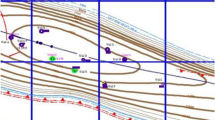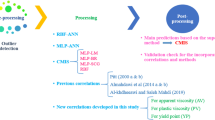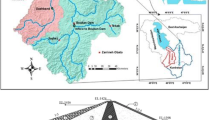Abstract
In order to have a better control over the drilling process and reduce the overall cost of this drilling operation, engineers have tried to use soft computing (SC) techniques to conduct the pre-estimation of drilling events. It is critically important to estimate the annular pressure losses (APL) for non-Newtonian drilling muds within annulus in order to specify pump rates and also to be able to choose the most appropriate mud pump systems while conducting the drilling operations. To develop the vigorous and exact models to enable the prediction of APL, two popular models were employed, i.e., multilayer perceptron (MLP) [optimized by Levenberg–Marquardt (LM), Bayesian regularization (BR), scaled conjugate gradient (SCG), resilient back propagation (RB), and Broyden–Fletcher–Goldfarb–Shanno (BFGS)] and radial basis function (RBF). Subsequently, applying a committee machine intelligent system (CMIS), the four top models were combined into a unit paradigm. Several tools such as error distribution diagram, cross plot, trend analysis, and cumulative frequency diagram were used in conjunction with statistical calculation to assess the efficiency of models. Consequently, the CMIS model was introduced as the most exact technique which has the greatest coefficient of determination (R2 close to one) as well as the lowest root-mean-square error (RMSE close to zero) for the tested dataset.










Similar content being viewed by others
Availability of data and materials
All the data in this manuscript are displayed in the supplementary file, otherwise contact me by email (imanjafarifar96@gmail.com).
Abbreviations
- APL:
-
Annular pressure loss
- AV:
-
Apparent viscosity
- ANN:
-
Artificial neural network
- ARE:
-
Absolute relative error
- AAPRE:
-
Average absolute percent relative error
- BR:
-
Bayesian regularization
- BFGS:
-
Broyden–Fletcher–Goldfarb–Shanno
- BNN:
-
Bayesian neural network
- BC:
-
Broyden class
- CMIS:
-
Committee machine intelligent system
- DFP:
-
Davidon–Fletcher–Powell
- ID:
-
Inside diameter
- ICOFC:
-
Iranian Central Oil Fields Company
- LM:
-
Levenberg–Marquardt
- MW:
-
Mud weight
- MLP:
-
Multilayer perceptron
- OD:
-
Outside diameter
- PRE:
-
Percent relative error
- PV:
-
Plastic viscosity
- QN:
-
Quasi-Newton
- RBF:
-
Radial basis function
- RB:
-
Resilient backpropagation algorithm
- RMSE:
-
Root-mean-square error
- RF:
-
Random forest
- R 2 :
-
Coefficient of determination
- SC:
-
Soft computing
- SCG:
-
Scaled conjugate gradient
- SR1:
-
Symmetric rank one
- SD:
-
Standard deviation
- SVM:
-
Support vector machines
- V :
-
Velocity of fluid
- YP:
-
Yield point
References
Ahmadi MA, Chen Z (2019) Machine learning models to predict bottom hole pressure in multi-phase flow in vertical oil production wells. The Canadian Journal of Chemical Engineering 97(11):2928–2940
Al-Khdheeawi EA, Mahdi DS (2019) Apparent viscosity prediction of water-based muds using empirical correlation and an artificial neural network. Energies 12(16):3067
Ameli F et al (2018) Modeling interfacial tension in N 2/n-alkane systems using corresponding state theory: application to gas injection processes. Fuel 222:779–791
Asadisaghandi J, Tahmasebi P (2011) Comparative evaluation of back-propagation neural network learning algorithms and empirical correlations for prediction of oil PVT properties in Iran oilfields. J Pet Sci Eng 78(2):464–475
Azari M, Soliman M (1997) Evaluation of slimhole production performance. In: SPE/IADC drilling conference. Society of Petroleum Engineers
Bazaraa MS, Sherali HD, Shetty CM (2013) Nonlinear programming: theory and algorithms. Wiley, New York
Broomhead DS, Lowe D (1988) Radial basis functions, multi-variable functional interpolation and adaptive networks. Royal Signals and Radar Establishment, Malvern
Brunsman BJ, Matson R, Shook RA (1994) Slim completions offer limited stimulation variances, part 3. Pet Eng Int 66:12
Chien S-F (1970) Laminar flow pressure loss and flow pattern transition of Bingham plastics in pipes and annuli. Int J Rock Mech Min Sci Geomech Abstr 7:339
Cohen JH, Maurer WC, Leitko CE (1995) High-power slim-hole drilling system. In: SPE annual technical conference and exhibition. Society of Petroleum Engineers
Cordes S, Moore G, Ramgoolam S (1995) Lectures on 2D Yang-Mills theory, equivariant cohomology and topological field theories. Nucl Phys B Proc Suppl 41(1–3):184–244
Dashti A, Harami HR, Rezakazemi M (2018) Accurate prediction of solubility of gases within H2-selective nanocomposite membranes using committee machine intelligent system. Int J Hydrog Energy 43(13):6614–6624
De Sousa J, et al (1999) Optimization of slimhole dual-body bits by experiments and computational fluid dynamics. In: SPE western regional meeting. Society of Petroleum Engineers
Enilari MG, Osisanya S, Ayeni K (2006) Development and evaluation of various drilling fluids for slim-hole wells. In: Canadian international petroleum conference. Petroleum Society of Canada
Foresee FD, Hagan MT (1997) Gauss-Newton approximation to Bayesian learning. In: Proceedings of international conference on neural networks (ICNN'97). IEEE
Ghiasi-Freez J, Kadkhodaie-Ilkhchi A, Ziaii M (2012) The application of committee machine with intelligent systems to the prediction of permeability from petrographic image analysis and well logs data: a case study from the south pars gas field. South Iran Petrol Sci Technol 30(20):2122–2136
Gul S, et al (2019) A data driven approach to predict frictional pressure losses in polymer-based fluids. In: SPE/IADC international drilling conference and exhibition. 2019. Society of Petroleum Engineers
Haciislamoglu M (1994) Practical pressure loss predictions in realistic annular geometries. In: SPE annual technical conference and exhibition. Society of Petroleum Engineers
Hagan MT, Menhaj MB (1994) Training feedforward networks with the Marquardt algorithm. IEEE Trans Neural Netw 5(6):989–993
Hagan M, Demuth H, Beale M (1996) Neural network design. PWS, Boston
Haji-Savameri M et al (2020) Modeling dew point pressure of gas condensate reservoirs: comparison of hybrid soft computing approaches, correlations, and thermodynamic models. J Pet Sci Eng 184:106558
Han S-M et al (2010) Solid–liquid hydrodynamics in a slim hole drilling annulus. J Pet Sci Eng 70(3–4):308–319
Hansen SA, et al. (1999) A new hydraulics model for slim hole drilling applications. In: SPE/IADC middle east drilling technology conference. Society of Petroleum Engineers
Hashem S, Schmeiser B (1993) Approximating a function and its derivatives using MSE-optimal linear combinations of trained feedforward neural networks. Purdue University, Department of Statistics
Haykin S (2007) Neural networks: a comprehensive foundation. Prentice Hall PTR, Pearson
Hemmati-Sarapardeh A et al (2016) Determination of minimum miscibility pressure in N2–crude oil system: a robust compositional model. Fuel 182:402–410
Hemmati-Sarapardeh A et al (2018) On the evaluation of the viscosity of nanofluid systems: Modeling and data assessment. Renew Sustain Energy Rev 81:313–329
Hinton GE (2010) Learning to represent visual input. Philoso Trans Royal Soc B Biol Sci 365(1537):177–184
Jafarifar I, Najjarpour M (2021) Modeling apparent viscosity, plastic viscosity and yield point in water-based drilling fluids: comparison of various soft computing approaches, developed correlations and a committee machine intelligent system. Arab J Sci Eng 47:1–25
Jafarifar I, Simi A (2023) Application of soft computing approaches for modeling fluid transport ratio of slim-hole wells in one of Iranian central oil fields. Earth Sci Inform 1–17
Jafarifar I et al (2020) Evaluation and optimization of water-salt based drilling fluids for slim-hole wells in one of Iranian central oil fields. Upstream Oil Gas Technol 5:100010
Jafarifar I, Norouzi-Apourvari S, Schaffie M, Ranjbar M (2023) Optimization of glycol–water-based drilling fluid for drilling slim-hole wells in one of Iranian central oil fields. Arab J Geosci 16(3):210
Kazemi-Beydokhti A, Hajiabadi SH (2018) Rheological investigation of smart polymer/carbon nanotube complex on properties of water-based drilling fluids. Colloids Surf A 556:23–29
Kelessidis VC, Dalamarinis P, Maglione R (2011) Experimental study and predictions of pressure losses of fluids modeled as Herschel–Bulkley in concentric and eccentric annuli in laminar, transitional and turbulent flows. J Pet Sci Eng 77(3–4):305–312
Kişi Ö, Uncuoğlu E (2005) Comparison of three back-propagation training algorithms for two case studies. CSIR, New Delhi
Kumar A et al (2020) Machine learning methods for Herschel–Bulkley fluids in annulus: pressure drop predictions and algorithm performance evaluation. Appl Sci 10(7):2588
Lopes Pereira V, Porter A, Jamison D (2022) Enhanced annular pressure drop modeling assists to drill extreme shallow ultra-ERD wells. In: Paper presented at the IADC/SPE international drilling conference and exhibition.
MacKay DJ (1992) Bayesian interpolation. Neural Comput 4(3):415–447
Maren AJ, Harston CT, Pap RM (2014) Handbook of neural computing applications. Academic Press, Cambridge
Mohaghegh S (2000) Virtual-intelligence applications in petroleum engineering: part 3—fuzzy logic. J Pet Technol 52(11):82–87
Mohammadi AH, Richon D (2007) Use of artificial neural networks for estimating water content of natural gases. Ind Eng Chem Res 46(4):1431–1438
Møller MF (1990) A scaled conjugate gradient algorithm for fast supervised learning. Aarhus University, Computer Science Department
Najafi-Marghmaleki A et al (2017) On the prediction of Watson characterization factor of hydrocarbons. J Mol Liq 231:419–429
Nakamoto P (2017) Neural networks and deep learning: deep learning explained to your granny a visual introduction for beginners who want to make their own deep learning neural network. CreateSpace Independent Publishing Platform, Scotts Valley
Nezhad AM, Shandiz RA, Jahromi AE (2013) A particle swarm–BFGS algorithm for nonlinear programming problems. Comput Oper Res 40(4):963–972
Nilsson NJ (1965) Learning machines
Osman E, Aggour M (2003) Determination of drilling mud density change with pressure and temperature made simple and accurate by ANN. In: Middle East oil show. Society of Petroleum Engineers
Ozbayoglu E, Ozbayoglu M (2009) Estimating flow patterns and frictional pressure losses of two-phase fluids in horizontal wellbores using artificial neural networks. Pet Sci Technol 27(2):135–149
Ozbayoglu EM, Sorgun M (2010) Frictional pressure loss estimation of non-Newtonian fluids in realistic annulus with pipe rotation. J Can Pet Technol 49(12):57–64
Ozbayoglu M et al (2010) Critical fluid velocities for removing cuttings bed inside horizontal and deviated wells. Pet Sci Technol 28(6):594–602
Ozbayoglu EM, Erge O, Ozbayoglu MA (2018) Predicting the pressure losses while the drillstring is buckled and rotating using artificial intelligence methods. J Nat Gas Sci Eng 56:72–80
Pan X, Lee B, Zhang C (2013) A comparison of neural network backpropagation algorithms for electricity load forecasting. In: 2013 IEEE international workshop on inteligent energy systems (IWIES). IEEE
Panda SS, Chakraborty D, Pal SK (2008) Flank wear prediction in drilling using back propagation neural network and radial basis function network. Appl Soft Comput 8(2):858–871
Perrone MP, Cooper LN (1992) When networks disagree: ensemble methods for hybrid neural networks. Brown Univ Provid Ri Inst Brain Neural Syst
Pks S, Yerubandi KB (2010) Slim well completions: a 3D numerical approach for displacement to design effective cementing fluids. In: Trinidad and Tobago energy resources conference. Society Of Petroleum Engineers
Razi M, Arz A, Naderi A (2013) Annular pressure loss while drilling prediction with artificial neural network modeling. Eur J Sci Res 95:272–288
Ribeiro P, Podio A, Sepehrnoor K (1994) The effect of rotational speed and eccentricity on annular flows with application to slim hole drilling hydraulics. In: SPE Latin America/Caribbean petroleum engineering conference. Society of Petroleum Engineers
Riedmiller M, Braun H (1993) A direct adaptive method for faster backpropagation learning: the RPROP algorithm. In: IEEE international conference on neural networks. IEEE
Rooki R (2015) Estimation of pressure loss of Herschel–Bulkley drilling fluids during horizontal annulus using artificial neural network. J Dispers Sci Technol 36(2):161–169
Rooki R (2016) Application of general regression neural network (GRNN) for indirect measuring pressure loss of Herschel–Bulkley drilling fluids in oil drilling. Measurement 85:184–191
Rostami A, Hemmati-Sarapardeh A, Shamshirband S (2018) Rigorous prognostication of natural gas viscosity: smart modeling and comparative study. Fuel 222:766–778
Rostami A et al (2019) Rigorous prognostication of permeability of heterogeneous carbonate oil reservoirs: smart modeling and correlation development. Fuel 236:110–123
Saasen A et al (1998) Is annular friction loss the key parameter? Oil Gas Eur Mag 24(1):22–24
Sagot A, Dupuis D (1994) A major step in ultra slimhole drilling. In: SPE annual technical conference and exhibition. Society of Petroleum Engineers
Scott RW, Earl JF (1961) Small diameter well completions, part 1: economics and application. World Oil
Shi X, He Q, Luo X, Bai Y, Shang M (2020) Large-scale and scalable latent factor analysis via distributed alternative stochastic gradient descent for recommender systems. IEEE Trans Big Data 8(2):420–431
Shokrollahi A, Tatar A, Safari H (2015) On accurate determination of PVT properties in crude oil systems: committee machine intelligent system modeling approach. J Taiwan Inst Chem Eng 55:17–26
Silva MA, Shah SN (2000) Friction pressure correlations of Newtonian and non-Newtonian fluids through concentric and eccentric annuli. In: SPE/ICoTA coiled tubing roundtable. Society of Petroleum Engineers
Song X, Guan Z (2012) Coupled modeling circulating temperature and pressure of gas–liquid two phase flow in deep water wells. J Pet Sci Eng 92:124–131
Sorgun M, Aydin I, Ozbayoglu ME (2011) Friction factors for hydraulic calculations considering presence of cuttings and pipe rotation in horizontal/highly-inclined wellbores. J Pet Sci Eng 78(2):407–414
Specht LP et al (2007) Modeling of asphalt-rubber rotational viscosity by statistical analysis and neural networks. Mater Res 10(1):69–74
Tomiwa O, et al. (2019) Improved water based mud using solanum tuberosum formulated biopolymer and application of artificial neural network in predicting mud rheological properties. In: SPE Nigeria annual international conference and exhibition. Society of Petroleum Engineers
Turnbull D, Elkan C (2005) Fast recognition of musical genres using RBF networks. IEEE Trans Knowl Data Eng 17(4):580–584
Uner D, Ozgen C, Tosum I (1989) Flow of a power-law fluid in an eccentric annulus (includes associated paper 20171). SPE Drill Eng 4(03):269–272
Van SL, Chon BH (2018) Effective prediction and management of a CO2 flooding process for enhancing oil recovery using artificial neural networks. J Energy Res Technol. https://doi.org/10.1115/1.4038054
Varamesh A et al (2017) Development of robust generalized models for estimating the normal boiling points of pure chemical compounds. J Mol Liq 242:59–69
Wang H, et al (2000) Experimental study of slimhole annular pressure loss and its field applications. In: IADC/SPE drilling conference. Society of Petroleum Engineers
Wu D, Luo X, Shang M, He Y, Wang G, Wu X (2020) A data-characteristic-aware latent factor model for web services QoS prediction. IEEE Trans Knowl Data Eng 34:2525
Yu L, Lai KK, Wang S (2008) Multistage RBF neural network ensemble learning for exchange rates forecasting. Neurocomputing 71(16–18):3295–3302
Yue Z, Songzheng Z, Tianshi L (2011) Bayesian regularization BP Neural Network model for predicting oil-gas drilling cost. In: 2011 International conference on business management and electronic information. IEEE
Zhang H et al (2020) Advanced orthogonal moth flame optimization with Broyden–Fletcher–Goldfarb–Shanno algorithm: framework and real-world problems. Expert Syst Appl 159:113617
Zhao N et al (2015) Modeling and prediction of viscosity of water-based nanofluids by radial basis function neural networks. Powder Technol 281:173–183
Zhou L, et al (2005) Hydraulics of drilling with aerated muds under simulated borehole conditions. In: SPE/IADC drilling conference. Society of Petroleum Engineers
Acknowledgements
The authors would like to thank Iranian Central Oil Fields Company (ICOFC) for supporting this study. The authors are also grateful to Dr. Robello Samuel, Chief Technical Advisor and Halliburton Technology Fellow for guidance and assistance.
Funding
This research received no specific grant from any funding agency.
Author information
Authors and Affiliations
Corresponding author
Ethics declarations
Conflict of interest
The authors declare that they have no known competing financial interests or personal relationships that could have appeared to influence the work reported in this paper. Also, I declare that this manuscript has been composed solely by myself and that it has not been submitted, in whole or in part, in any previous article. Except where states otherwise by reference or acknowledgment, the work presented is entirely my own.
Ethical approval
This article does not contain any studies with human participants or animals performed by any of the authors.
Informed consent
Informed consent was obtained from all individual participants included in the study.
Additional information
Publisher's Note
Springer Nature remains neutral with regard to jurisdictional claims in published maps and institutional affiliations.
Supplementary Information
Below is the link to the electronic supplementary material.
Rights and permissions
Springer Nature or its licensor (e.g. a society or other partner) holds exclusive rights to this article under a publishing agreement with the author(s) or other rightsholder(s); author self-archiving of the accepted manuscript version of this article is solely governed by the terms of such publishing agreement and applicable law.
About this article
Cite this article
Jafarifar, I., Simi, A., Abbasi, H. et al. Application of soft computing approaches for modeling annular pressure loss of slim-hole wells in one of Iranian central oil fields. Soft Comput 27, 16125–16142 (2023). https://doi.org/10.1007/s00500-023-07986-4
Accepted:
Published:
Issue Date:
DOI: https://doi.org/10.1007/s00500-023-07986-4




